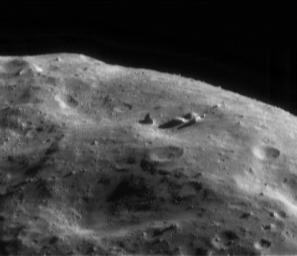
|
Pretty Sharp
- Click the image above for a larger view
- Full-Res JPEG (477 x 412) (20.6 kB)
- Full-Res TIFF (477 x 412) (158.7 kB)
Caption:
Pictures taken during the low-orbit phase of NEAR Shoemaker's mission to Eros are revealing the true appearance of an asteroid's surface. Eros is turning out to have diverse surface types ranging from flat to hilly, smooth to rocky, and monotonously cratered to unique in character.
This picture was taken for "optical navigation," that is, plotting the spacecraft's course by tracking the positions of the landmarks below. It caught a spectacular view of a horizon sculpted by worn, degraded craters and punctuated by jagged boulders. The angular boulder at the center of the frame is about 60 meters (197 feet) tall, or two-thirds the length of a football field. Angular rocks are very common in nature; the corners form as a rock is chipped out of a larger mass.
This image was taken May 18, 2000, from an orbital altitude of 50 kilometers (31 miles). The whole scene is about 1.4 kilometers (0.8 miles) across, and it shows features as small as 4 meters (13 feet).
Background Info:
Built and managed by The Johns Hopkins University Applied Physics Laboratory, Laurel, Maryland, NEAR was the first spacecraft launched in NASA's Discovery Program of low-cost, small-scale planetary missions. See the NEAR web page at http://near.jhuapl.edu/ for more details.
Cataloging Keywords:
| Name | Value | Additional Values |
|---|---|---|
| Target | 433 Eros | |
| System | Near Earth Objects | |
| Target Type | Asteroid | |
| Mission | NEAR Shoemaker | |
| Instrument Host | NEAR Shoemaker | |
| Host Type | Orbiter | |
| Instrument | Multi-Spectral Imager (MSI) | |
| Detector | ||
| Extra Keywords | Crater, Grayscale | |
| Acquisition Date | ||
| Release Date | 2000-06-10 | |
| Date in Caption | 2000-05-18 | |
| Image Credit | NASA/JPL/JHUAPL | |
| Source | photojournal.jpl.nasa.gov/catalog/PIA02912 | |
| Identifier | PIA02912 | |
